Natural plant infusions elevate your artisan creations through three main methods: water-based steeping for aromatic teas, oil infusions for capturing fat-soluble properties, and alcohol tinctures for maximum preservation. Each technique extracts unique elements—calendula, chamomile, and lavender offer anti-inflammatory benefits in soaps, while different methods yield varying color intensities. Store your extracts in dark amber bottles with proper labeling for longevity. Discover how seasonal botanicals can transform your creations into signature seasonal offerings.
Understanding the Magic of Plant-Based Infusions
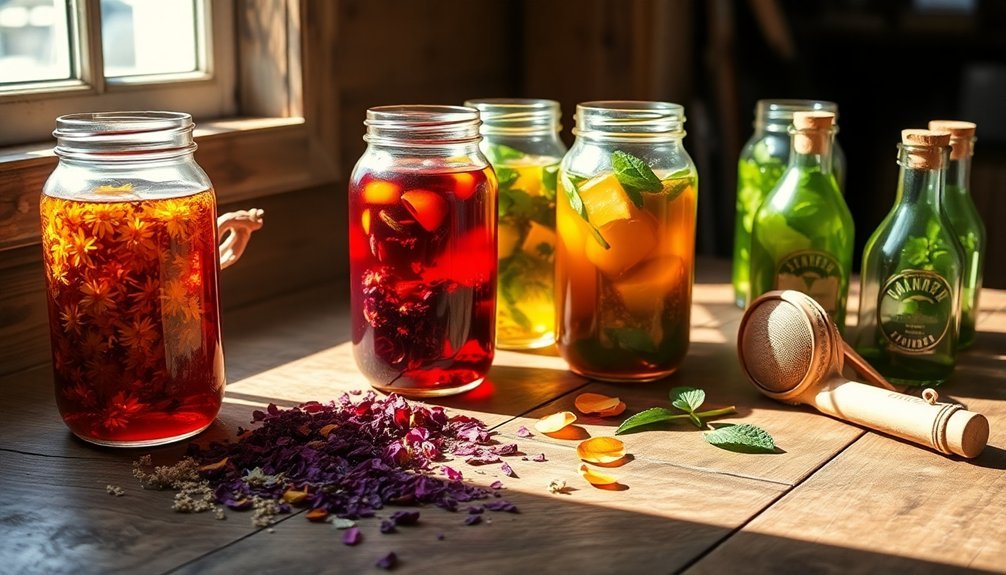
When you explore the world of plant-based infusions, you're tapping into centuries of traditional wisdom that harnesses nature's pharmacy.
These herbal extractions capture the essence of plants—their flavors, aromas, and medicinal qualities—creating versatile preparations for both culinary and therapeutic uses.
The extraction method you choose shapes the final product. Water-based infusions create flavorful teas by steeping dried herbs in hot water.
Oil-based methods require patience, with herbs soaking in carrier oils for 4-6 weeks to produce nutrient-rich solutions perfect for topical applications.
Alcohol-based tinctures offer yet another option for preserving plant properties.
What makes these infusions so valuable is their concentrated nutritional profile—packed with antioxidants, vitamins, and minerals that can enhance your daily wellness rituals.
Essential Botanical Extracts for Natural Soapmaking
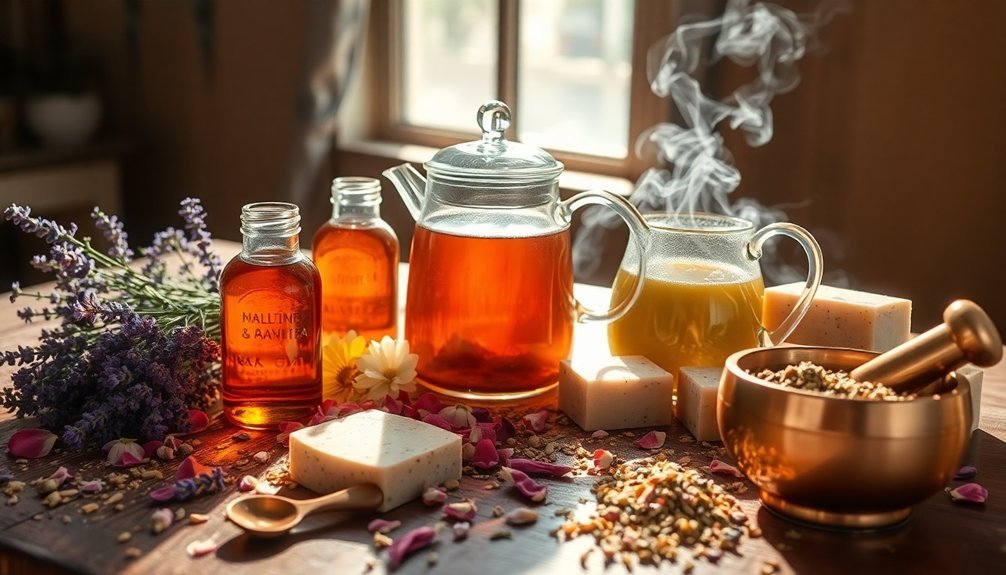
Three key botanical extracts stand at the forefront of natural soapmaking, transforming ordinary bars into skin-nourishing treasures. Calendula, chamomile, and lavender bring their soothing anti-inflammatory properties to your soap while adding delightful natural fragrance.
You'll find herbal infusions particularly effective when created through cold infusion methods—simply combine your chosen botanical with a carrier oil and allow nature's beneficial compounds to transfer. For rosemary or peppermint soap, infused oils deliver therapeutic benefits without synthetic additives.
Remember to monitor your extract concentration carefully. Too much can overwhelm your soap with intense color or scent. The goal is balance—just enough botanical power to enhance your soap's properties while maintaining a harmonious final product that pampers skin naturally.
Creating Vibrant Color Profiles With Herb and Flower Infusions
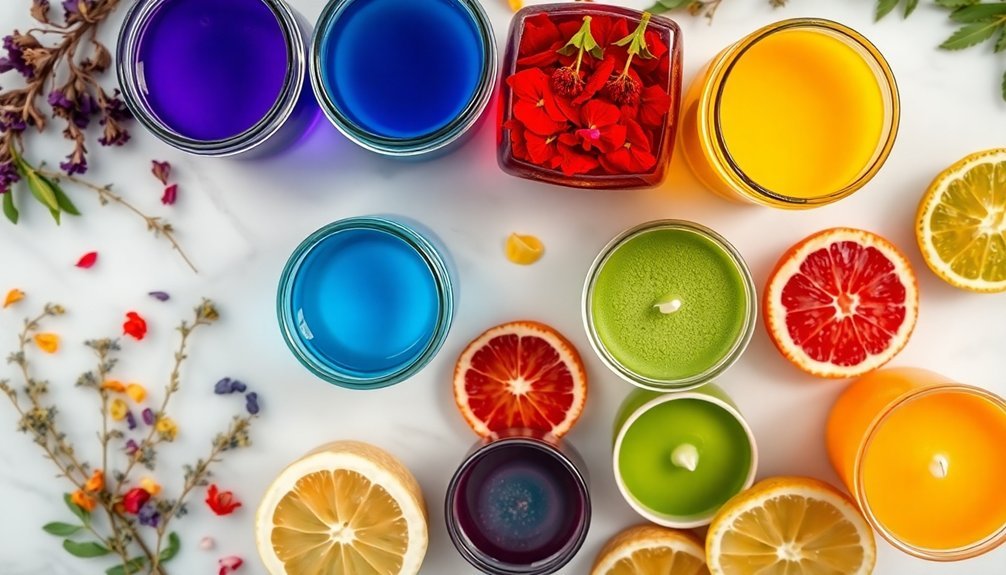
Your extraction method will directly impact the vibrancy and longevity of plant-based colors, with cold infusions preserving delicate pigments while hot methods yield stronger hues.
You'll need to understand natural color fixatives like alum or vinegar that prevent your botanical dyes from fading over time or with exposure to light.
Our thorough plant-to-product guide helps you match specific herbs and flowers to your desired color outcome, ensuring predictable results in your culinary and cosmetic creations.
Extraction Methods Matter
The extraction method you choose can dramatically transform the visual and flavor profile of your herbal infusions. Each technique reveals different properties from your natural botanicals, affecting both appearance and therapeutic benefits.
Water-based infusions create vibrant colors and clean flavors, perfect for teas when steeped for at least 15 minutes.
Oil-based methods extract deeper hues and medicinal compounds, ideal for topical applications.
Alcohol-based tinctures preserve the full spectrum of natural herbal properties without preservatives.
Consider these sensory experiences when selecting your method:
- Golden chamomile oil catching sunlight in a glass bottle
- Deep crimson hibiscus tea steaming in a white porcelain cup
- Emerald-green cannabis tincture in a dropper bottle
- Delicate lavender-infused almond oil with floating purple buds
Color-Fixing Natural Dyes
Beyond their therapeutic benefits, plant infusions reveal a spectacular array of natural dyes that transform ordinary projects into living color stories.
When you steep dried plant material like Blue Butterfly Pea Flower in hot water, you'll extract pigments that respond dynamically to their environment—watch blues shift to purples with just a drop of lemon juice.
You can create a personalized palette by experimenting with concentration levels and combining different botanicals.
Hibiscus yields rich reds, turmeric produces sunny yellows, and indigo delivers deep blues—all without harsh chemicals found in synthetic alternatives.
These natural color-fixers aren't just visually striking; they're environmentally responsible choices for your textiles and food projects.
Plant-to-Product Color Guide
With plant dyeing skills in hand, let's explore specific ingredients that create predictable color results across various projects.
The highest quality natural infusions offer consistent colors you can rely on while enhancing your creations with beneficial properties.
- Blue Butterfly Pea Flower steeps into a deep azure that transforms to vibrant purple when citrus is added—perfect for color-changing beverages and soaps.
- Calendula petals infuse oils with golden-yellow hues that bring warmth to balms and culinary oils while adding skin-soothing properties.
- Hibiscus flowers yield rich burgundy tones that deepen with longer steeping times, ideal for dramatic food presentations.
- Purple Sweet Potato Powder creates lavender to deep violet shades while boosting nutritional value in baked goods.
Adjust concentration by varying steeping time or ingredient amounts to customize your color palette for any application.
Oil vs. Water vs. Alcohol: Choosing the Right Infusion Medium
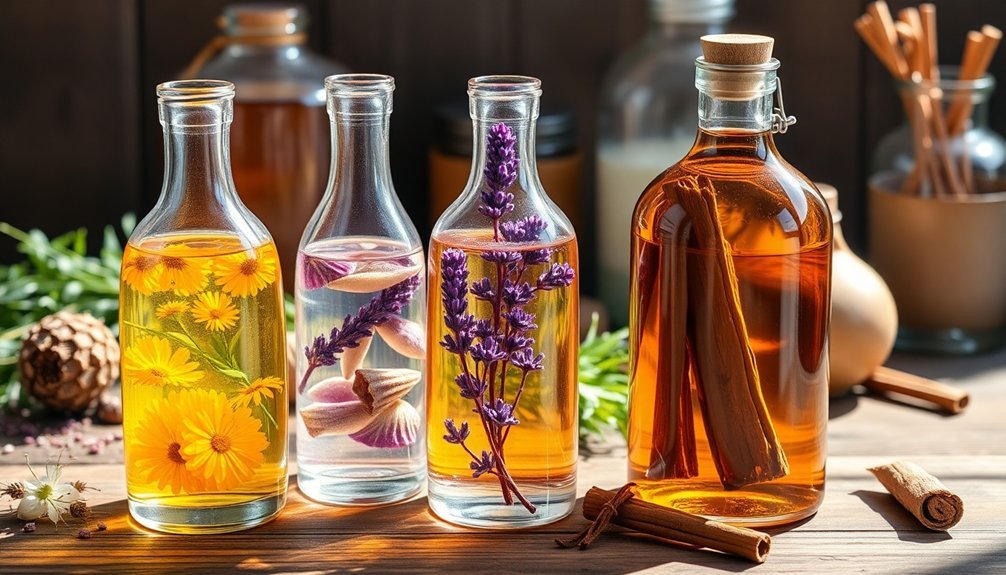
When creating plant infusions, your choice of medium—oil, water, or alcohol—dramatically affects both the properties extracted and the final product's applications. Olive oil makes an excellent carrier for topical preparations, capturing fat-soluble plant compounds for salves and balms.
| Medium | Extracts | Best For |
|---|---|---|
| Oil | Fat-soluble compounds | Salves, balms, massage oils |
| Water | Water-soluble properties | Teas, compresses, skin toners |
| Alcohol | Both volatile and non-volatile compounds | Tinctures, internal remedies |
Each medium offers unique advantages: water infusions are simple to prepare but have shorter shelf lives; oil infusions require patience but yield versatile products; alcohol extracts are potent and preservative-free. Match your medium to your intended use—don't choose alcohol for salves or water for long-term storage.
Time-Tested Techniques for Extracting Plant Properties
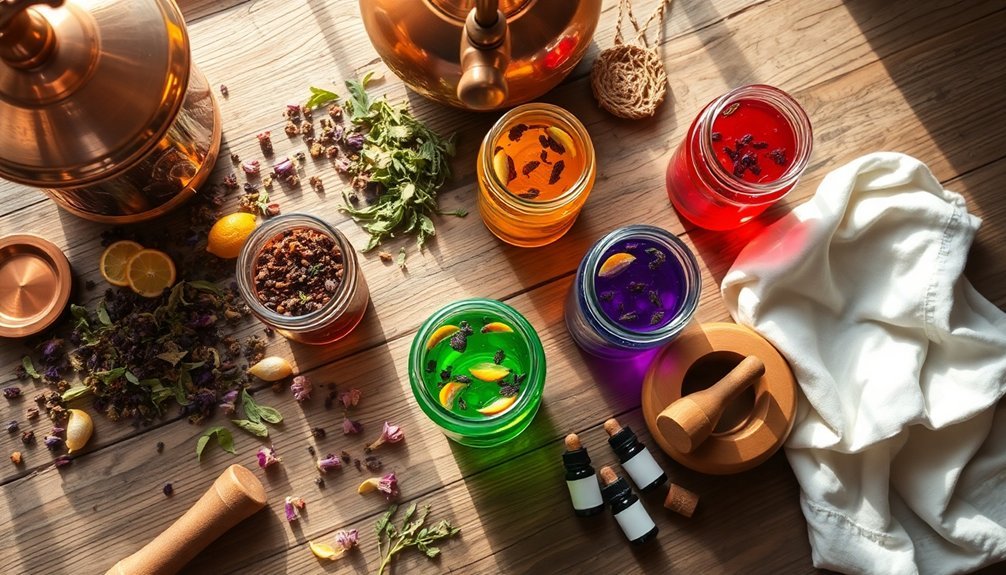
Ancient wisdom meets modern practice in the four primary methods herbalists rely on to extract nature's beneficial compounds.
When making herbal preparations, you'll need to choose the technique that best suits your intended use.
- Water infusions dancing in steaming cups, releasing aromatic compounds as herbs steep for 15 minutes in near-boiling water
- Oil infusions gently bubbling for hours, capturing fat-soluble plant properties as they transfer into golden carrier oils
- Tinctures sitting patiently in dark cabinets, alcohol drawing out potent constituents for preservation and internal remedies
- Cold infusions resting quietly for weeks, slowly extracting delicate properties without heat damage
After your chosen method has worked its magic, strain the mixture through cheesecloth to remove solid particles, leaving you with a concentrated herbal preparation ready for your artisan creations.
Blending Infusions for Signature Scent Profiles
Layering complementary botanicals in your infusions creates complex, nuanced profiles that can't be achieved with single-ingredient extracts.
You'll find that mapping your scent combinations by season allows you to capture nature's rhythmic changes, with bright citrus and florals for spring and warm, woody notes for autumn.
Remember to balance your top, middle, and base notes for a well-rounded signature scent that evolves pleasantly over time.
Layering Complementary Botanicals
The art of blending botanical infusions opens a world of aromatic possibilities for those seeking signature scent profiles.
When you layer complementary botanicals, you're crafting a unique olfactory experience that reflects your creative vision and intention.
Start with a 1:2 ratio of stronger to milder botanicals for balanced results. While dried herbs offer concentrated aromas, fresh herbs can introduce bright, vibrant notes to your creations.
Document your experimental processes—whether cold or oil-based infusions—to refine your technique over time.
- Pair floral Blue Butterfly Pea Flower with earthy Cloves for depth
- Balance citrus undertones with woody base notes for lasting impressions
- Contrast sweet elements with herbaceous accents for complexity
- Layer time-released scents that unfold gradually as they warm
Seasonal Scent Mapping
As seasons shift throughout the year, your signature scent profiles can evolve to capture nature's changing palette.
Create distinctive seasonal infusions by thoughtfully combining herbs that reflect each season's essence—floral notes for spring, invigorating mint for summer, and warming spices for winter are often used to evoke specific memories and emotions.
Experiment with blue butterfly pea flower to add visual drama to your creations; its color-changing properties when mixed with citrus create stunning effects while delivering unique aromatic experiences.
Consider the health benefits each herb brings: cooling chamomile soothes summer blends, while warming cloves provide comfort in winter infusions.
Preserving and Maximizing the Potency of Your Botanical Extracts
Successful preservation of your herbal extracts depends primarily on your choice of solvent and storage methods. High-proof alcohol and glycerin work best for extracting and stabilizing beneficial compounds, with alcohol-based tinctures offering impressive shelf life without preservatives.
For oil infusions, select long-lasting carrier oils like Olive or Jojoba to prevent rancidity and maintain therapeutic properties.
Always store your creations properly:
- Dark amber bottles lined up on wooden shelves, protected from sunlight's degrading rays
- A collection of tinctures with handwritten labels in a cool pantry drawer
- Glass dropper bottles of various sizes sealed with cork stoppers
- A wooden box with compartments housing differently colored extracts
Regularly inspect your extracts—any off odors or color changes indicate it's time to replace them.
Frequently Asked Questions
How Do You Make Homemade Herbal Infusions?
You'll need to choose dried herbs, use sanitized jars, and decide on a base. For water infusions, steep herbs in hot water. For oil infusions, combine herbs with oil and heat gently before straining.
Do Herbal Infusions Really Work?
Yes, herbal infusions really work! You'll benefit from their vitamins, minerals, and antioxidants that support your health. They're effective both internally and externally, offering digestive support, immune boosting, and wellness benefits without harsh chemicals.
What Are Examples of Herbal Infusions?
You'll find many herbal infusions, including chamomile tea for relaxation, peppermint for digestion, lavender-infused oil for skin care, and rosemary tinctures for hair health. Each extracts unique properties through water, oil, or alcohol.
What Is the Difference Between Extract and Infusion?
Extracts are concentrated plant compounds made with alcohol or glycerin, while infusions are milder preparations where you steep herbs in hot water or oil. You'll use extracts in smaller amounts as they're more potent.
In Summary
You've now accessed the botanical secrets to transform your artisan creations into truly unique treasures. By selecting the right infusion methods and plant combinations, you'll create products that stand out with authentic colors, scents, and properties. Don't be afraid to experiment—each infusion is an opportunity to develop your signature style. Your natural, plant-powered creations aren't just products; they're expressions of nature's wisdom through your hands.

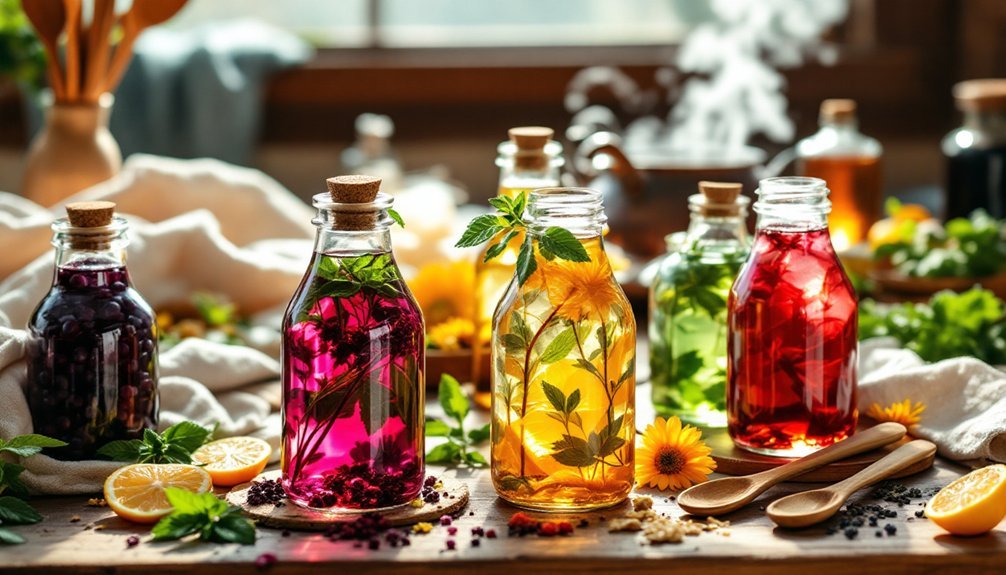



Leave a Reply